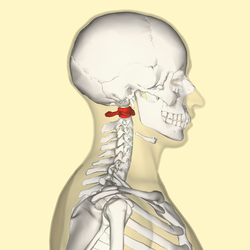
Back Atlas (werwel) Afrikaans أطلسية (تشريح) Arabic Гарбач AV Atlas (fəqərə) Azerbaijani Атлант (анатомия) Bashkir Атлас (анатомия) Bulgarian Atles (os) Catalan Atlas (obratel) Czech Атлант (анатоми) CV Atlas (anatomi) Danish
This article needs additional citations for verification. (April 2019) |
| Atlas (anatomy) | |
|---|---|
 Position of the atlas shown in red | |
| Details | |
| Identifiers | |
| Latin | atlas, vertebra cervicalis I |
| MeSH | D001270 |
| TA98 | A02.2.02.101 |
| TA2 | 1038 |
| FMA | 12519 |
| Anatomical terms of bone | |
In anatomy, the atlas (C1) is the most superior (first) cervical vertebra of the spine and is located in the neck.
The bone is named for Atlas of Greek mythology, just as Atlas bore the weight of the heavens, the first cervical vertebra supports the head.[1] However, the term atlas was first used by the ancient Romans for the seventh cervical vertebra (C7) due to its suitability for supporting burdens.[2] In Greek mythology, Atlas was condemned to bear the weight of the heavens as punishment for rebelling against Zeus. Ancient depictions of Atlas show the globe of the heavens resting at the base of his neck, on C7. Sometime around 1522, anatomists decided to call the first cervical vertebra the atlas.[2] Scholars believe that by switching the designation atlas from the seventh to the first cervical vertebra Renaissance anatomists were commenting that the point of man’s burden had shifted from his shoulders to his head--that man’s true burden was not a physical load, but rather, his mind.[2]
The atlas is the topmost vertebra and the axis (the vertebra below it) forms the joint connecting the skull and spine. The atlas and axis are specialized to allow a greater range of motion than normal vertebrae. They are responsible for the nodding and rotation movements of the head.
The atlanto-occipital joint allows the head to nod up and down on the vertebral column. The dens acts as a pivot that allows the atlas and attached head to rotate on the axis, side to side.
The atlas's chief peculiarity is that it has no body,[3] which has fused with the next vertebra.[4] It is ring-like and consists of an anterior and a posterior arch and two lateral masses.
The atlas and axis are important neurologically because the brainstem extends down to the axis.
- ^ "Table of Bones, Atlas". Dorland's Pocket Medical Dictionary (Abridged from Dorland's Illustrated Medical Dictionary) (20th ed.). W. B. Saunders Companh. 1959. p. B-16. LCCN 98-578. Retrieved September 23, 2023 – via Internet Archive.
- ^ a b c Jackowe, David J.; Biener, Michael G. (June 2022). "Atlas and Talus". Journal of Anatomy. 240 (6): 1174–1178. doi:10.1111/joa.13613. ISSN 0021-8782. PMC 9119609.
- ^ Moulton, Andrew (2009). "Clinically Relevant Spinal Anatomy". Surgical Management of Spinal Deformities: 13–43. doi:10.1016/B978-141603372-1.50005-6. ISBN 9781416033721.
- ^ Gray, Henry (1924). Anatomy of the Human Body. Warren H. Lewis (edited and revised by) (21st ed.). Lea & Febiger. p. 97 – via Internet Archive.